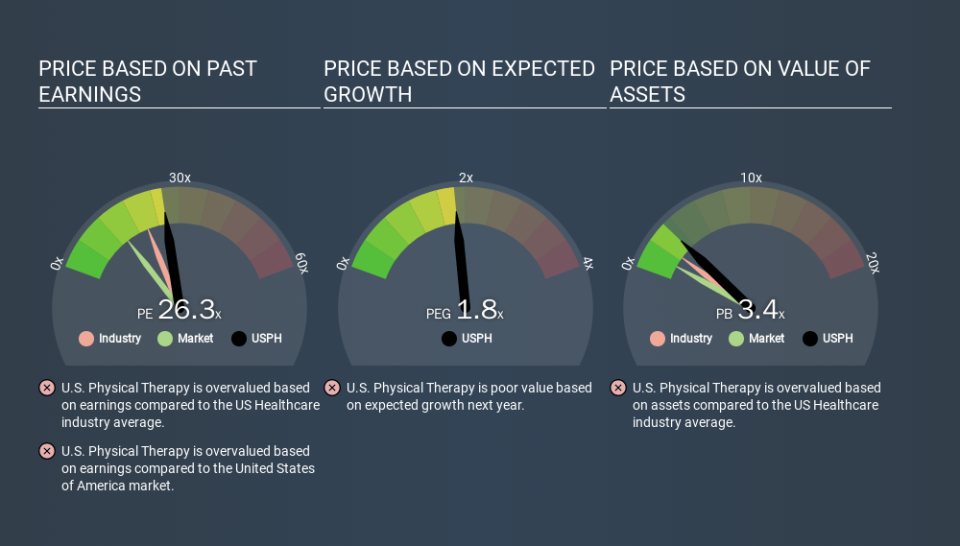A Sliding Share Price Has Us Looking At U.S. Physical Therapy, Inc.'s (NYSE:USPH) P/E Ratio

To the annoyance of some shareholders, U.S. Physical Therapy (NYSE:USPH) shares are down a considerable 49% in the last month. That drop has capped off a tough year for shareholders, with the share price down 39% in that time.
All else being equal, a share price drop should make a stock more attractive to potential investors. In the long term, share prices tend to follow earnings per share, but in the short term prices bounce around in response to short term factors (which are not always obvious). So, on certain occasions, long term focussed investors try to take advantage of pessimistic expectations to buy shares at a better price. One way to gauge market expectations of a stock is to look at its Price to Earnings Ratio (PE Ratio). Investors have optimistic expectations of companies with higher P/E ratios, compared to companies with lower P/E ratios.
View our latest analysis for U.S. Physical Therapy
How Does U.S. Physical Therapy's P/E Ratio Compare To Its Peers?
U.S. Physical Therapy's P/E of 26.30 indicates some degree of optimism towards the stock. The image below shows that U.S. Physical Therapy has a higher P/E than the average (16.9) P/E for companies in the healthcare industry.
That means that the market expects U.S. Physical Therapy will outperform other companies in its industry. Shareholders are clearly optimistic, but the future is always uncertain. So further research is always essential. I often monitor director buying and selling.
How Growth Rates Impact P/E Ratios
Generally speaking the rate of earnings growth has a profound impact on a company's P/E multiple. When earnings grow, the 'E' increases, over time. And in that case, the P/E ratio itself will drop rather quickly. And as that P/E ratio drops, the company will look cheap, unless its share price increases.
In the last year, U.S. Physical Therapy grew EPS like Taylor Swift grew her fan base back in 2010; the 87% gain was both fast and well deserved. Having said that, the average EPS growth over the last three years wasn't so good, coming in at 14%.
Remember: P/E Ratios Don't Consider The Balance Sheet
It's important to note that the P/E ratio considers the market capitalization, not the enterprise value. Thus, the metric does not reflect cash or debt held by the company. Hypothetically, a company could reduce its future P/E ratio by spending its cash (or taking on debt) to achieve higher earnings.
Such spending might be good or bad, overall, but the key point here is that you need to look at debt to understand the P/E ratio in context.
U.S. Physical Therapy's Balance Sheet
Net debt totals just 3.3% of U.S. Physical Therapy's market cap. The market might award it a higher P/E ratio if it had net cash, but its unlikely this low level of net borrowing is having a big impact on the P/E multiple.
The Verdict On U.S. Physical Therapy's P/E Ratio
U.S. Physical Therapy's P/E is 26.3 which is above average (12.7) in its market. While the company does use modest debt, its recent earnings growth is superb. So on this analysis a high P/E ratio seems reasonable. Given U.S. Physical Therapy's P/E ratio has declined from 51.3 to 26.3 in the last month, we know for sure that the market is significantly less confident about the business today, than it was back then. For those who don't like to trade against momentum, that could be a warning sign, but a contrarian investor might want to take a closer look.
When the market is wrong about a stock, it gives savvy investors an opportunity. As value investor Benjamin Graham famously said, 'In the short run, the market is a voting machine but in the long run, it is a weighing machine. So this free visual report on analyst forecasts could hold the key to an excellent investment decision.
But note: U.S. Physical Therapy may not be the best stock to buy. So take a peek at this free list of interesting companies with strong recent earnings growth (and a P/E ratio below 20).
If you spot an error that warrants correction, please contact the editor at editorial-team@simplywallst.com. This article by Simply Wall St is general in nature. It does not constitute a recommendation to buy or sell any stock, and does not take account of your objectives, or your financial situation. Simply Wall St has no position in the stocks mentioned.
We aim to bring you long-term focused research analysis driven by fundamental data. Note that our analysis may not factor in the latest price-sensitive company announcements or qualitative material. Thank you for reading.

 Yahoo Finance
Yahoo Finance 
